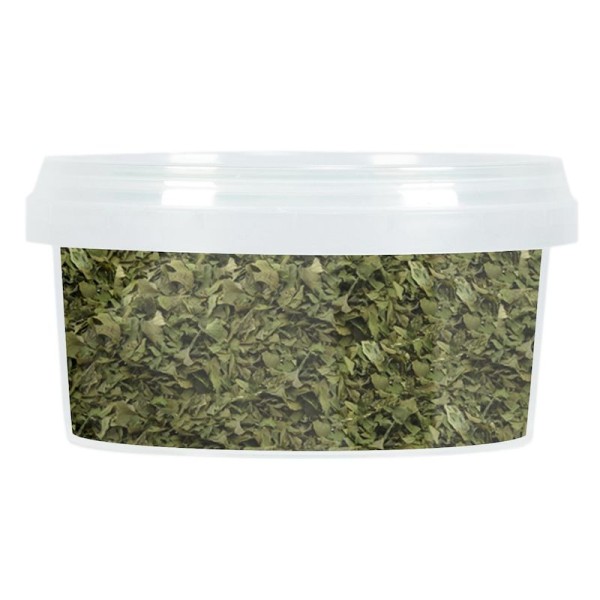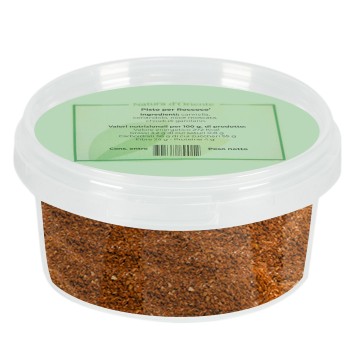Parsley, a precious herb in the kitchen
This aromatic herb is very common in the kitchen, and we know that “being like parsley” comes from the fact that it is a very versatile ingredient. Parsley is used for its fresh and vibrant flavor, as well as for its green color that garnishes perfectly at the end of cooking.
What are the properties of parsley?
Not only is it a fundamental element in many recipes: parsley also offers benefits for the body, which make it a favorite ingredient in the pantry cupboard. It is an herb used by man for centuries, for its nutritional properties, since parsley contains a series of vitamins, minerals and other essential nutrients. It becomes a healthy addition as it is a source of vitamins A, C and K, as well as folic acid and other B vitamins. It contains minerals such as iron, potassium and calcium, as well as being an herb rich in antioxidants such as flavonoids and carotenoids. These compounds help protect the body from cellular damage caused by free radicals. It is a delicious aromatic herb, useful for increasing nutrient intake and improving well-being. In addition, parsley is believed to have natural beneficial properties for bones, thanks to vitamin K, and for eyesight, as it contains the plant compounds lutein, zeaxanthin and beta-carotene. Traditionally, a bunch of parsley infused for about 5-10 minutes, was used for a purifying and diuretic herbal tea, which helps combat water retention; excellent in combination with vegetables or fruits in detox centrifuges. It is also beneficial for promoting digestion and reducing the production of intestinal gas; it also facilitates the functionality of the urinary tract, alleviating menstrual cycle disorders. It also has sudorific properties due to a substance contained in the herb; in Chinese herbal medicine it is used to regulate blood pressure through sweating and diuresis. Cold parsley infusion can be useful for external use on hair (a compress to make it shiny) or as a facial tonic to lighten the skin.
Are there any contraindications for parsley?
Although it is a safe food, excessive consumption is not recommended during pregnancy as it could trigger uterotonic effects (stimulates uterine contractions). Furthermore, in excessive doses it could exacerbate kidney problems. In addition, parsley can be harmful to cats and small pets.
Choose to buy quality parsley
You can buy it in the Natura d'Oriente online spice shop, where you can find this aromatic herb selected, dried and ready to season your dishes. This version is perfect for preserving parsley at its best, in freshness-saving packaging. You will have the possibility to buy parsley with a variable weight of 25g, 50g, 75g, 100g, 250g, 500g and 1 kg. The sales and delivery services reserve you a great price on parsley and other loose spices.
How to use dried parsley in recipes?
Parsley's versatility makes it a condiment to add flavor and color to many dishes, which is why it is known as a garnish and a flavoring. It adds a herbaceous touch to many dishes, to which it gives a persistent freshness in the aroma, a pungent and slightly bitter flavor. The concentrated character of dried parsley enlivens food and complements the flavor of many other aromatic herbs.
Savory recipes: parsley is very popular for flavoring soups, broths and cream soups. It is added to salads and vegetables, it goes well with onions, omelettes and egg-based dishes - to be mixed before cooking and completed with a final sprinkling. It adds flavour to potato dishes such as mashed potatoes, boiled potatoes and gnocchi. It adds a herbaceous touch to mushrooms and cheeses, and is special when paired with risotto or polenta.
Pasta recipes: excellent in sauces for first courses, in stuffed pasta fillings and as a condiment, for example in pasta with ricotta and parsley. It is exquisite in clam sauce, in spaghetti allo scoglio and in simple pasta with garlic, oil and parsley.
Meat and fish: the most common herb in seafood cuisine, it adds a fresh character that is perfect when grilling fish. It adapts to and enlivens the flavours of roast fish and seafood, exquisite on steamed fish, it is used in the preparation of seafood soups and in mussels with pepper. On meat it adds a herbaceous touch to stews and boiled meats (in particularenhances white meat); flavors ground meat and meatballs. It is excellent in marinades before grilling and in dry rubs (dry rubs for meat): its intense flavor holds up well to the bold notes of garlic and citrus.
Sauces: it is an ingredient in many preparations, especially chopped to flavor creams and sauces for fish and meat, or served with croutons. Famous are zogghiu (Sicilian mint and parsley sauce), parsley pesto and parsley sauce (a classic accompaniment to fish that combines the aromatic herb with butter, flour, milk and other spices). In addition, parsley is mixed with oil and garlic to season grilled vegetables. It is also used in vegetable or fruit juices, for an intense touch.
International cuisine: A key seasoning in Lebanese tabbouleh (a tomato, cucumber and bulgur salad), and is also used in the Middle East in falafel and hummus. It adds a spicy note to dishes such as chimichurri and Thai green curry.
Blends: Combines with other herbs, adding a fresh, grassy flavour; pairs well with herbs such as thyme, chives, tarragon, rosemary and oregano.
Parsley tea: 2 teaspoons dried parsley leaves in 250ml boiling water. Steep for 5-10 minutes. The minimum time (5-6 minutes) reduces the bitterness of the herbal tea, while leaving the leaves for up to 10 minutes gives a progressively more intense flavor, which you can sweeten to taste.
How do you cook with dried parsley?
It has many properties useful for culinary creations, combined with both cooked and raw dishes with great adaptability. Parsley is used to garnish dishes for aesthetic reasons or to infuse an aromatic and intense touch. It is used both on dishes at the end of cooking and for the preparation of sauces. Depending on the recipe, parsley can be used whole, chopped or finely chopped. In the kitchen, when used in preparations on the stove or in sautéing, parsley can be incorporated towards the end of cooking, to ensure that its flavor is preserved. In fact, heat destroys its essential oils and promotes the appearance of an unpleasant bitter aroma. The version of parsley already cleaned, chopped and ready, is convenient to be inserted immediately as a garnish and for the centrifuge. The addition of parsley is very popular in innovative dishes, with creative recipes, in which it is added with spices such as cumin.
The Recipe: Lo Zogghiu
This is an ancient Sicilian recipe used by fishermen to season fish with an exceptionally fresh sauce, based on mint and parsley. It is perhaps of Arab-Maltese origin, given that it takes its name from the word zejjet (season with oil). Today it is used both with grilled fish and with roasted white meats, it can also season bruschetta and sandwich fillings. Ingredients
1 handful of mint (leaves) – 2 sprigs of parsley - 2 cloves of garlic (without outer skin) - 1 tablespoon of red wine vinegar - 1 glass of extra virgin olive oil - salt - ground black pepper Preparation
Put the mint, parsley, garlic and a pinch of salt in the blender, working at low speed to create a soft and uniform mixture. Alternatively, you can crush them in a mortar. Pour into a bowl and set aside. Separately, prepare the oil and vinegar emulsion in a bowl. Pour them in a thin stream, little by little, perhaps using a ladle. Add the black pepper and another pinch of salt. Transfer the oil and vinegar emulsion to the spice bowl, to mix. The zogghiu sauce must be smooth and thick, ready to flavor recipes.
Where does parsley come from?
This aromatic herb has ancient origins and a very long history. As a plant it has different varieties, and the most widespread in Italy is the common parsley with small leaves, botanically defined Petroselinum Hortense and part of the Apiaceae family. The name Petroselinum is of Greek origin since it was well known by ancient peoples, and is still one of the most cultivated plants in the world. Parsley is native to southern Europe and northern Africa, in fact it grows spontaneously in temperate climates and fears the cold. It shows off its bright green color, hairless leaves and has been known for centuries as edible together with the stems.
The ancient Greeks already used it for particular social as well as culinary purposes; They adorned their heads with parsley when they attended banquets, convinced that the scent ofparsley brought joy and stimulated the appetite. The Romans used it as a symbol to decorate the tombs of family members, while the Etruscans considered it a magical plant, useful in rituals or in preparing ointments. The presence of this herb became common in the kitchen, hence the saying "to be like parsley" was born to indicate something or someone that is found everywhere. In its original version in the Mediterranean region, parsley was then introduced to other parts of the world by traders and explorers, with great success in all cuisines. Even from the herbalist point of view, in ancient times the crushed or crushed leaves were used to make compresses, useful against insect bites or to treat decayed teeth. The roots of the plant also constituted basic elements for ointments. Parsley juice was used to stop nosebleeds, while the stem was used to create love potions and the decoction was taken as an aphrodisiac. This last virtue was perhaps linked to its vital power (rapid growth, even in the heat).
In the mid-nineteenth century, parsley began to be used as a natural remedy for female well-being, when some researchers confirmed its emmenagogue properties: it stimulates the flow of blood in the pelvic area and in the uterus, in order to promote menstruation. It is due to a substance, apiol, which helps to contract the smooth muscles of the intestine, bladder and uterus. Today in contemporary cuisine, parsley is used in abundance to flavor sauces and fillings, and especially to garnish many recipes.









 No reward points for this product.
No reward points for this product.















